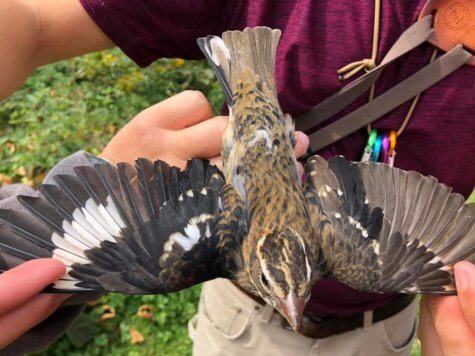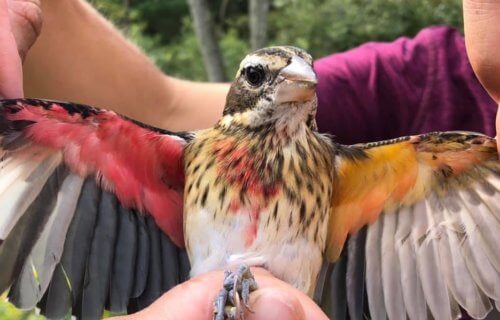PITTSBURGH, Pa. — The term “unicorn” gets used a lot these days to describe things that are rare and special. In Pennsylvania, researchers have made a discovery that may truly embody the legendary creature. The Carnegie Museum of Natural History says a team has found a bird that is both male and female, with the sexes split right down the middle of its feathers.
Researchers at Powdermill Nature Reserve made the extraordinary find on Sept. 24, 2020. While catching and banding birds for the Avian Research Center, the team came across a Rose-breasted Grosbeak. These birds have distinct colors depending on their gender (sexually dimorphic), but this is no ordinary Grosbeak. The bird researchers discovered is a gynandromorph.

Gynandromorphs are genetically both male and female. In this bird’s case, the Rose-breasted Grosbeak is male on its right side and female on its left. A typical male will have a pink breast spot and “wing pits,” with black wing feathers. Females have yellow wing pits and browner wings.
‘Fascinating genetic process that few encounter’
The museum reports that in its 64 years of bird banding, Powdermill’s Avian Research Center has spotted less than 10 bilateral gynandromorphs. This one is believed to have hatched sometime last year at the earliest.
“The entire banding team was very excited to see such a rarity up close, and are riding the high of this once-in-a-lifetime experience,” says bird banding program manager Annie Lindsay in a press release.
“One of them described it as ‘seeing a unicorn’ and another described the adrenaline rush of seeing something so remarkable. They all are incredibly grateful to be part of such a noteworthy and interesting banding record. Bilateral gynandromorphism, while very uncommon, is normal and provides an excellent example of a fascinating genetic process that few people ever encounter.”
Can gynandromorphs reproduce?
Researchers say this rare bird actually has the necessary organs to mate with other Rose-breasted Grosbeaks. The team adds the left ovary in birds is usually the only one that functions. Since this particular gynandromorph is female on its left side, the researcher center believes it could successfully mate with a male.
One obstacle it faces however is its mating song. Researchers explain that if the gynandromorph sings like a male, it may end up attracting females and provoke other males into a territorial fight.
